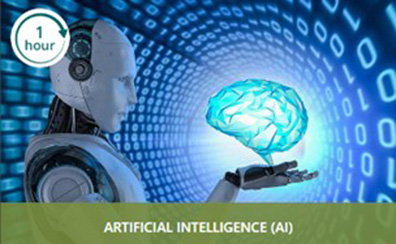Take the AI Professional Refresher to earn 60 mins CPD
The idea of embracing artificial intelligence (AI) in the workplace is to work smarter, not harder. According to our Professional Refresher on the subject, “there is no widely accepted definition of AI” but it can be regarded as “technologies with the ability to perform tasks that would otherwise require human intelligence” and “that have the capacity to learn or adapt to new experiences or stimuli”.
AI is an umbrella term encompassing tech such as machine learning (ML), visual perception, speech recognition, language translation, and the capacity to learn new experiences. Within financial services, it can assess risk, predict outcomes, and process transactions more efficiently, which saves on costs, accelerates customer service, and creates more reliable financial assessments, such as credit risk.
Our module, which counts as one hour towards your continuing professional development, will take you through the impacts of AI and explain how it is used in many divisions in the sector, such as in robo-advisers for investment guidance.
Here’s a preview of what you will learn, chapter by chapter. All quotes and facts are taken from the module.

Chapters 1 and 2: Background and history
AI’s history runs alongside the development of computing and begins with cryptography deciphering during WWII. Governments and academics conducted research into AI after the war but the public did not have much exposure to it initially, apart from in fiction.
We identify two classifications: narrow and general. Narrow refers to most systems in the world today, whereas general artificial intelligence is “the ability to achieve unlimited goals or even to set new goals independently”. An example of the latter would be ChatGPT, a chatbot jointly developed by Microsoft and OpenAI, which launched in November 2022 and went viral in early 2023. It uses a language-based model and can provide customer service with exceptionally detailed and informed responses at the user’s request.
Chapter 3: Development trends
The module describes AI’s ability to sift through large datasets and how this contributes to life-changing research. It highlights a case study by Public Health England from 2009 – a data project to quantify the ways in which people were diagnosed with cancer. Algorithms analysed 118 million records on two million patients. Analysis showed that by 2013, “just 20% of cancers were diagnosed as an emergency”. The understanding gained from this data project continues to inform public health initiatives.
Chapter 4: Jargon
This chapter includes definitions of ‘big data’, ‘algorithms’, and ‘deep learning’, and provides links to further reading.
Chapters 5 and 6: Machine learning
One of the fastest-growing approaches to achieving AI is through machine learning. It has the ability to learn and improve through either supervised learning, in which algorithms are based on labelled datasets that enable them to create models on which predictions can be based, or unsupervised learning, in which the algorithms look for irregularities without being given any instructions.
Deep learning uses a subset of ML tools and is “loosely inspired by the structure of the human brain”. It relies on artificial neural networks and can extract features from unstructured data.
Predictive coding is a type of ML that can "'predict’ how documents can be classified based on limited human input”. It can, for example, review thousands of legal documents before a case to determine if they need to be handed over to the court.
Chapter 7: Financial servicesAI uses in finance include:
- Robo-advice
- Chatbots
- Fraud detection and risk management
- Regulatory compliance
- Stock predictions
- Credit approval
The module gives a breakdown of each point.
Chapters 8 and 9: Risks and ethics
Considering the myriad ways AI is used and the large number of actors that can contribute to its deployment, AI presents various new risks that we need to consider. Those developing the systems may exacerbate the systemic biases of the real world by choosing specific pools of data and excluding others, for example. Algorithms in these systems can then reinforce patterns of discrimination. We specify these risks in the module.
The module highlights work by the Institute of Business Ethics, which uses a framework for the ethical use of AI, consisting of fundamental values and principles including transparency, fairness, and integrity, some of which align with the CISI’s values. Essentially, following this framework will help you follow the CISI Code of Conduct.
Chapter 10: Data protection law and regulation ethics
A significant piece of legislation to follow is the EU Commission’s draft Artificial Intelligence Regulation, published in 2021. It sets out requirements mainly on the creators of AI systems. It is the first of its kind in the world and is “opening up a new discourse about how to regulate artificial intelligence”.
AI is a scare for some but a segue to the future for others. The financial services sector is seeing more and more research into its current uses and its potential, so it is vitally important to keep up.